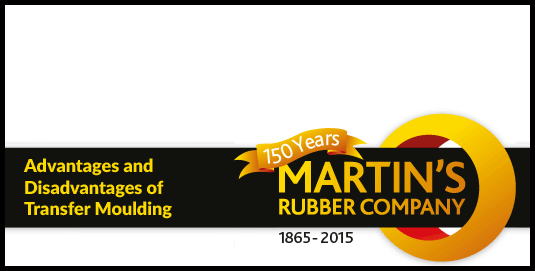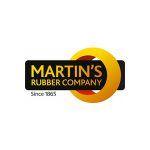Advantages and Disadvantages of Transfer Moulding
Within this article, Martin’s Rubber explains what Transfer Moulding is and demonstrates some of the key advantages and disadvantages of producing a Transfer Mould and the overall process.
Transfer moulding is one of the numerous ways in which engineers manufacture rubber parts. Transfer Moulding is the process of loading a raw material prepared into “pre-forms” into a pot integral to the mould tool. The material is measured and inserted prior to the moulding process taking place. Once the mould is closed, this material is then preheated and loaded into the pot.

This is an ideal process for forming parts which may require exact positioning inserts to be bonded, intricate parts with lower production requirements and mould designs that contain multiple cavities or can trap air. The mouldings provided are far less likely to exhibit knit lines or other defects, creating a much more consistent approach to production. This process is ideal when looking to produce plastic or rubber parts with metal inserts. For example, Transfer moulding is an excellent way to create composite seals with insert moulding, which then float inside the cavity.
Given that cavities are not reliant upon one another, they are able to move freely rather than being cut directly into the same plate. This helps to absorb variations in tolerances, so the mould will stay consistent.
Various inserts made from plastic and metal can be used to make composite seals and other products, which allow for multi-component sealing solutions, helping reduce overall component count in assemblies and providing a more resilient product.
Advantages:
Shorter production cycles for higher weight parts
Transfer moulding offers shorter production cycle times than traditional moulding techniques, such as compression moulding, as the compound preparation and product finishing time is greatly reduced. This means there is less cutting and flash. Cure times are reduced since the rubber enters the mould cavity at a higher and even temperature, and can thus begin to cure more quickly.
Tighter dimensional tolerance
The overall process also allows for much tighter tolerances, leading to more complex parts, which is difficult to achieve with compression moulding. Given that the mould is not held open by surplus material spilling out of the cavity parting line, any excess holds the plunger open from the pot, therefore not affecting the actual part being produced.
Provides better uniformity
The pot and plunger design allows for more standardisation and lower costs of tooling, and the process is more consistent than Compression moulding, with less variables. The fact that the mould is closed before accepting the shot means that the parts are more dimensionally consistent across a production run.
Reduced tooling lead times compared to a full Injection tool
In relation to Injection Moulding, Transfer Moulding tooling offers much shorter lead-times with less ancilliary features required. This means that the production run is ready faster with far less tooling costs.
More accurate and consistent than compression moulding
Transfer moulding allows for much sharper edges, since rubber enters the cavity at near the curing temperature. This vastly reduces any tendency for “backrinding”, which can be a risk with Compression moulding. This occurs when rubber cures unevenly in a mould, and the action of expansion, cure and shrink tears off pieces of rubber around the split line of a mould. This is countered by increasing the width of the split line in a Compression tool, but greatly increases the overall deflashing necessary as a consequence. Transfer Moulding generally eliminates this issue, and thus allows for sharper split lines.
Disadvantages:
More expensive tooling than a Compression mould
Due to the more complex nature of the design of the moulds, tooling investment can be somewhat higher.
Slower production cycle than an injection tool
The Transfer moulding process is usually slower than an injection tool, sometimes limiting the overall production rate, as changeover times can be somewhat extended.
Manual handling of the piston can be a problem
The skill level is often proportionately higher and for larger parts or tools, manual handling can become somewhat of an issue.
Overall, the process of Transfer moulding is ideal when looking to form: parts which require exact positioning of inserts to be bonded, and/or intricate parts with lower volume requirements and mould designs that contain multiple cavities or can trap air. This process is also best suited to those seeking a much more consistent approach to production. Although it may be more expensive than a compression mould, transfer moulding offers shorter production cycle times than traditional moulding, as there is less cutting and flash and can be a good intermediate step between the tooling economy of Compression moulding and the capital expense of Injection moulding.
Get the latest process industry news
Interested in receiving even more industry-leading news from Process Industry Forum delivered directly to your inbox? Then sign up to our free newsletter. Bringing you the latest news, trends, innovations and opinion from across the process industry, our exclusive newsletter gives you all the industry insights of the moment in one, easy-to-digest bulletin. Stay ahead of the competition with regular process industry news instalments from PIF.

